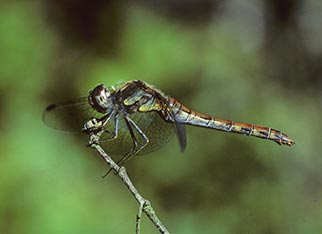Common Darter (Sympetrum striolatum)
How many:
Relatively abundant and widespread

Common Darters can be seen in flight from mid-June, but it is as a late flying insect that they are perhaps most conspicuous. Regularly on the wing until the end of October, or occasionally into early November, they are often the last dragonfly of the year to be seen.
Mature males have orange-red coloured abdomens, whilst the abdomens of mature females are initially a dullish yellow-brown colour before, with age, they develop patches of red, pale green, brown and blue. Wingspan is around 5.5 centimetres, whilst length is almost 4 centimetres.
Newly emerged insects of both sexes - in what is known as the teneral phase, which typically lasts for around 7 days - are primarily of yellowish hue.
Although often found around still water, they are also frequently seen on heathland and along woodland rides. They are often confiding creatures that allow a close approach providing, of course, that care is taken to avoid rapid or jerky movements. Sticks or twigs are frequently used as perches and they can also often be seen resting on bare patches of ground or on the railings of bridges that carry paths over boggy areas.
As the name suggests, Common Darters are common and widespread in the New Forest.
References:
A Guide to the Dragonflies of Great Britain: Dan Powell
Dragonflies and Damselflies of Britain and Northern Europe: Bob Gibbons
More links
Other related links
Search this site

Sadly, 58 animals were killed - 35 ponies, 13 cows, 8 donkeys and 2 sheep, whilst a further 32 were injured - 3 pigs, 9 donkeys, 11 cows and 9 ponies.
(Forty-three accidents occurred in daylight, 15 at twilight and 101 in the dark. Twenty-seven accidents were not reported by the driver involved).
Here's just one horrific example - Three donkeys killed in collision with van at notorious New Forest blackspot (Advertiser and Times)

